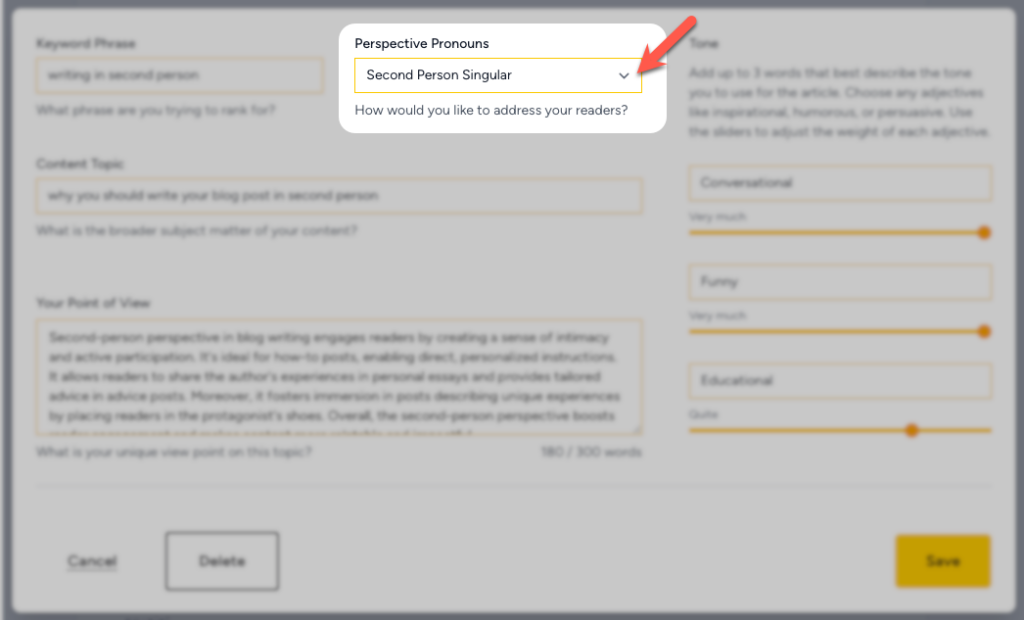Writing in the Second Person: Why It’s Beneficial for Your Blog
The second-person perspective in blog writing engages readers by creating a sense of intimacy and active participation. It’s ideal for how-to posts, enabling direct, personalized instructions. It allows readers to share the author’s experiences in personal essays and provides tailored advice in advice posts. Moreover, it fosters immersion in posts describing unique experiences by placing readers in the protagonist’s shoes. Overall, the second-person perspective boosts reader engagement and makes content more relatable and impactful.
So, let’s dive in and discover the power of the second person!
Understanding Perspective Pronouns
Before we delve into the wonders of the second person, let’s briefly touch on perspective pronouns. Perspective pronouns are those little words that indicate the point of view from which a piece of writing is being presented. They shape the entire tone and feel of your content, so choosing the right pronouns is crucial.
When you’re using the second person, the perspective pronouns you need to focus on are “you,” “your,” and “yours.” These pronouns directly address your readers and create a sense of connection. By using these pronouns, you can make your readers feel like you’re having a one-on-one conversation with them, making your content more personal and engaging.
Second-Person Point-of-view Examples
- “You walk down the street, feeling the sun on your face and the breeze in your hair.”
- “You close your eyes and take a deep breath, feeling the stress of the day melt away.”
- “You sit down at your computer and start to write, feeling the words flow freely from your fingertips.”
What is Second-Person Perspective?
Now that we have our perspective pronouns fresh in our minds, let’s focus on the star of the show: the second person! The second-person perspective is all about creating a sense of intimacy and active participation with your readers. It’s like having a heart-to-heart conversation with each and every one of them. By directly addressing your audience as “you,” you’ll make them feel like they’re right there with you, experiencing everything firsthand.
Engaging How-To Posts
One of the biggest advantages of writing in the second person is its effectiveness in how-to posts. When explaining step-by-step processes or providing instructions, the second person allows you to give direct, personalized guidance. It’s like having a personal mentor guiding you through every little detail. So, the next time you’re explaining how to bake the perfect chocolate chip cookies or change a flat tire, consider using the second person to make your instructions come alive!
Sharing Personal Experiences in Personal Essays
In personal essays, the second-person perspective enables readers to share the author’s experiences as if they were their own. It’s like stepping into someone else’s shoes and seeing the world through their eyes. This level of intimacy and connection can make your personal stories resonate deeply with your readers, creating a powerful emotional impact.
Tailored Advice in Advice Posts
When it comes to advice posts, the second person is a fantastic tool for providing tailored guidance. By addressing your readers directly, you can offer specific advice and suggestions that feel personalized to their unique situations. Whether you’re giving dating tips or offering career advice, writing in the second person ensures that your words hit home.
Immersion in Descriptive Posts
Imagine reading a blog post that takes you on a thrilling adventure, describing every sight, sound, and smell in vivid detail. By using the second person, the author can immerse you in their experiences, making you feel like the protagonist of the story. It’s an incredible way to captivate readers and transport them to a different world.
Using Quillbee to Write in the Second Person
Now that we understand the power of the second person, let me introduce you to an amazing tool called Quillbee. Quillbee is a writing assistant that makes crafting second-person content a breeze.
Six Perspective Pronoun Settings
Quillbee comes with six perspective pronoun settings, including second-person singular and second-person plural. This means that regardless of whether you’re addressing an individual or a group, Quillbee has got you covered. It’s like having a personal writing coach who knows the ins and outs of the second person!
Difference Between Second-Person Singular and Plural
Before we proceed, let’s quickly discuss the difference between second-person singular and plural. Second-person singular refers to addressing an individual reader, using pronouns like “you” and “your.” On the other hand, second-person plural involves addressing a group of readers, using pronouns like “you all” and “your.” So, whether you want to connect with one person or a whole community, Quillbee has the right pronouns for the job.
Generating Second-Person Content with Quillbee
Now, let’s get down to business and see how Quillbee can help you generate second-person content. It’s as easy as pie! Simply select “First Person (Singular or Plural)” from the Perspective Pronouns dropdown field, and Quillbee will do the rest. It’s like having a magic wand that transforms your writing into a captivating conversation with your readers.

Embrace Writing in the Second Person to Elevate Your Blog Posts
So there you have it! Writing your blog posts in the second person can take your content to new heights. By engaging your readers and making them active participants in your writing, you’ll create a sense of intimacy and connection that can’t be achieved with any other perspective.
And with Quillbee by your side, you’ll have all the tools you need to master the art of the second person. So go ahead, give it a try, and watch your reader engagement soar!
Ready to enhance your writing? Try Quillbee today!
Ready to take your blog writing to the next level with the power of the second person? Try Quillbee today and see the difference it can make in your content. Your readers will thank you, and you’ll wonder how you ever wrote without it!







